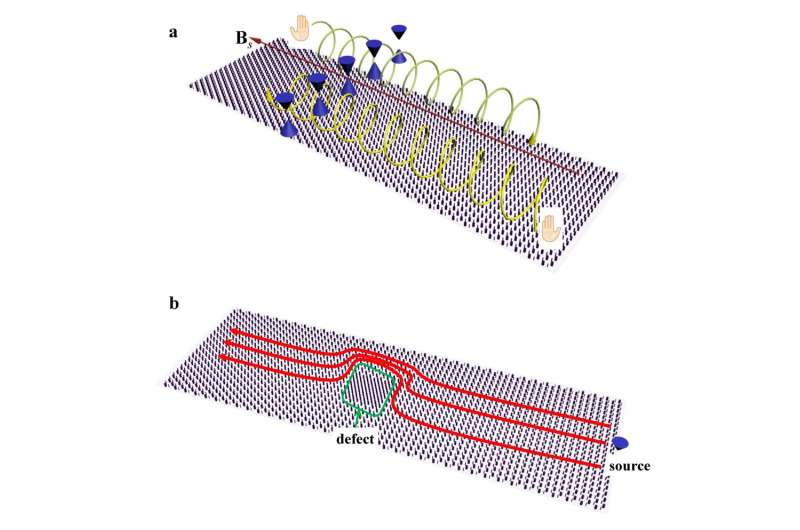This article has been reviewed according to Science X's editorial process and policies. Editors have highlighted the following attributes while ensuring the content's credibility:
fact-checked
peer-reviewed publication
trusted source
proofread
An inhomogeneous Dirac cone system gives rise to in-plane chiral Landau levels

Chiral zeroth Landau levels are topologically protected bulk states that propagate in a single direction. In the field of quantum field theory and condensed matter physics, these levels are crucial for breaking chiral symmetry and triggering the chiral anomaly, which involves the non-conservation of chiral currents in both particle physics and condensed matter systems.
However, previous approaches to realizing chiral Landau levels have relied on 3D Weyl degeneracies and background magnetic fields, which pose challenges for sample fabrication and limit practical applications.
In a recent publication in Light: Science & Applications, Professor C. T. Chan from the Department of Physics at Hong Kong University of Science and Technology, Hong Kong, China, along with a team of scientists, introduced a novel approach. By breaking local parity inversion symmetry within each unit cell, they designed a 2D Dirac cone photonic system with inhomogeneous effective mass.
This inhomogeneous effective mass created a synthetic gauge field in a virtual direction, which interacted with the Dirac degeneracy. Through their work, they successfully extended the chiral Landau levels from 3D to 2D systems and experimentally validated their one-way propagative nature.
Additionally, they introduced defects into the system and conducted experiments to test the robustness of the chiral zeroth Landau levels against back-scattering. These findings significantly simplify sample fabrication and hold potential for applications in one-way optical design.
In contrast to topologically protected surface states, bulk states offer greater accessibility for utilization in communication devices. This is due to the confinement of energy within the system for bulk states, whereas edge states have energy that is primarily localized near the system's boundary, making them more prone to leakage. The scientists conducting the research summarized the underlying physics, exceptional properties, and potential applications of these bulk states:
"Our objective is to expand the concept of chiral zeroth Landau levels from 3D Weyl systems to 2D Dirac cone systems. To achieve this, we recognize that a 2D Dirac cone system can be considered as a subsystem of a 3D Weyl system by introducing a virtual direction represented by the effective mass of the Dirac cone," they said.
"By making the effective mass inhomogeneous, we can redefine the momentum in this virtual direction as a virtual canonical momentum. Consequently, this gives rise to a synthetic magnetic field on the 2D plane, which interacts with the Dirac cone and leads to the formation of in-plane chiral Landau levels."
"Due to the fact that a single Dirac cone supports only one chiral zeroth Landau level, the scattering transition from a positively propagating zeroth mode to a negatively propagating mode is comparable to an intervalley scattering. However, this process poses significant challenges as the two valleys are widely separated in momentum space, making such transitions very difficult to occur," they added.
"The inherent robustness of the chiral zeroth bulk mode against backscattering from defects is the key factor behind its exceptional properties. This characteristic makes it highly suitable for applications in one-way optical waveguide design. By scaling down the sample size from millimeters to nanometers, it becomes applicable in the optical frequency range. This opens up opportunities for its widespread use in communication devices, effectively minimizing energy leakage. The confined energy within the bulk enables efficient management of information transport, further enhancing its accessibility," the scientists say.
More information: Hongwei Jia et al, Experimental realization of chiral Landau levels in two-dimensional Dirac cone systems with inhomogeneous effective mass, Light: Science & Applications (2023). DOI: 10.1038/s41377-023-01209-z
Journal information: Light: Science & Applications
Provided by Chinese Academy of Sciences




















